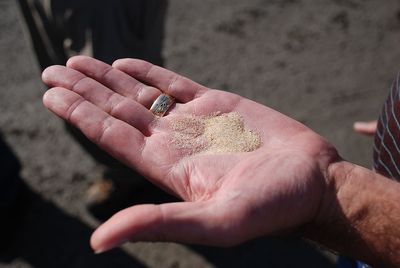Proppant

Proppant is a gritty material with uniformly sized particles that is mixed in with fracturing fluid during the hydraulic fracturing (fracking) process to hold open fractures made in the ground. There are a variety of different types of proppant, including naturally occurring sand and man-made proppants. Man made proppants include materials such as resin-coated sand or strong ceramic materials. Proppants come in a variety of different sizes and spherical shapes for a variety of different situations.[2]
Recently, demand for proppants has increased as oil and natural gas wells are being made to yield more oil and gas using hydraulic fracturing. One job can require a few thousand tons of this proppant material.[3]
Types
There are several different types of materials used as proppant. The first of these types is known as frac sand, and is simply a high-purity quartz sand with durable, round grains. As a result of its strength it is crush-resistant, and thus is effective as propping open cracks made in the ground during the hydraulic fracturing process. Most of this sand is made from high purity sandstone.[3] Although natural, this frac sand is not used directly out of the ground, rather it requires processing. The processing process involves washing to remove particles that are too small, and then a screening process to ensure the remaining grains are the correct size.
Other types of proppant materials include resin-coated sand and ceramic proppants. Resin-coated sand is simply sand that is coated in a resin material to smooth the surface of the sand and make the shape more uniform. Along with this, coating the sand in resin increases its strength, making it more desirable as a proppant. Finally, ceramic proppants are the most uniform in shape and the strongest of the proppants as their manufacturing is entirely controlled. The uniform shape of this type of proppant ensures that there is more space for the oil and gas to flow through the proppant material and out of the well.[4]
Size and Shape
Proppants come in a variety of different grain sizes, as well as different shapes. The size and shape of a proppant is important as it influences the final permeability in the induced fracture. Frac sand, or naturally occurring sand-type proppant is generally irregular in shape, although this depends on the source. Compared to other types of proppants it has a low strength and packs together closely in fractures, resulting in a lower permeability when compared to other proppant types. Resin-coated sand is more smooth and round in shape, and is stronger than traditional frac sand. As a result of this shape and texture, resin-coated sand does not pack as closely together and thus is more permeable than frac sand. Finally, ceramic proppant is the most uniform shaped and most round proppant. It has a high strength, and as a result of its properties it is also very permeable, allowing trapped oil or natural gas to flow easily out of the fractures.[5]
References
- ↑ Wikimedia Commons. (January 9, 2015). USGS Hydraulic Fracturing Sand [Online]. Available: https://upload.wikimedia.org/wikipedia/commons/thumb/5/51/USGS_Hydraulic_Fracturing_Sand.jpg/1280px-USGS_Hydraulic_Fracturing_Sand.jpg
- ↑ Schlumberger. (January 9, 2015). Proppant [Online]. Available: http://www.glossary.oilfield.slb.com/en/Terms/p/proppant.aspx
- ↑ 3.0 3.1 Geology.com. (January 9, 2016). Frac Sand [Online]. Available: http://geology.com/articles/frac-sand/
- ↑ CARBO. (January 9, 2015). Ceramic Proppant [Online]. Available: http://www.carboceramics.com/ceramic-proppant
- ↑ Horiba. (January 9, 2015). Frac Sand [Online]. Available: http://www.horiba.com/scientific/products/particle-characterization/applications/frac-sand/

